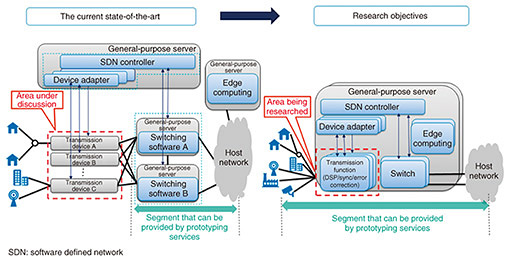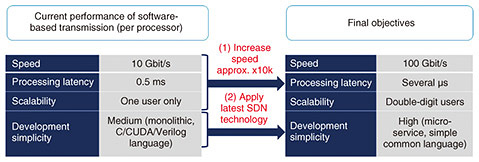Software-based optical access network virtualization technology for implementing low-latency and high-reliability networks with flexibility
—Could you tell us about “software-based optical access network virtualization technology”?
Optical access network virtualization technology separates the control functions from the transmission functions in transmission equipment for optical access systems, and moving the control functions to a general-purpose server enables unified control and management of communications equipment. We are also researching use of software technology to implement functions of the transmission equipment itself, so that it can also be implemented on general-purpose servers.
Conventional optical access systems have incorporated network specifications, which have been different for each vendor, in dedicated hardware, so they could only be used for their original purpose. Such dedicated hardware also required a huge amount of time and expense to complete the design and development of each system, so that when introducing a new service, the transmission equipment and control systems had to be developed at large scale, and it was necessary to carefully consider in detail whether the service would be able to generate the revenue required when it was introduced. Software-based optical access network virtualization technology provides a solution for such difficulties.
By virtualizing optical access networks with software, functions in the optical access system transmission equipment itself can be replaced easily, so that various requirements for access can be accommodated. With software, development cycles can also be shortened, so that even if there is a problem after the system is installed, it can be corrected repeatedly with updates. Thus, this research enables services to be prototyped and verified easily, so that new services can be created one after another.
—What are some methods used for software-based optical access network virtualization technology?
Some specific transmission functions required for software-based optical access network virtualization technology include frame synchronization, error-correction coding, a scrambler function, and digital signal processing (DSP), and we implement these functions on a general-purpose server. Software cannot achieve the performance possible with dedicated hardware, so we utilize general-purpose accelerator hardware to increase performance. We are also working on other ways to resolve this issue, such as devising technology to transmit the input signals to the processing devices at high speed, making radical changes to the transmission algorithms themselves to create low-computation algorithms that achieve the same performance, and creating high-speed processing technologies that coordinate between central processing units and accelerators efficiently.
Figure 1 shows our initiatives in software-based optical access network virtualization and what we ultimately aim to achieve. Currently, my research focuses on a network prototyping service, and with the latest results, we can implement the control functions with SDN Enabled Broadband Access (SEBA), which is open-source software from the Open Networking Foundation (ONF). In the future, by also implementing transmission system components in software on general-purpose servers, we aim to expand the domain over which “free prototyping” can be done, from only the host network as was the case earlier, to enable free network prototyping across both the user and host networks. This will allow testing of various types of services.

Fig. 1. Software-based optical access network virtualization technology overview.
Future telecommunications services implemented using software-based optical access network virtualization technology
—Could you tell us about your future expectations for use of software-based optical access network virtualization technology?
Currently, research is advancing on DSP for future high-speed access systems and this is still done with a basic assumption that it will be implemented in dedicated hardware, but we hope to implement it in software. In fact, several of the functions comprising this DSP can be processed using a graphics processing unit, as is already being done in areas such as artificial intelligence, achieving results with throughput of 10 Gbit/s. However, when considering expandability and how many users can be connected, we are still limited to a single user, which is inadequate, and it is still not “developer friendly” enough to enable prototyping of various services.
Figure 2 shows the current state and final target for software-based optical access network virtualization technology. Our next target is to build a 100 Gbit/s-class system to handle the constantly increasing user traffic, which is an increase of approximately 10,000 times current speeds. Other targets are to reduce processing latency to a few microseconds, and to increase the number of users that can be accommodated into the double-digits. To implement network prototyping that is very easy, we will also need to create micro-services, reducing the size of functional components that can be developed, and use a common language to simplify development.

Fig. 2. Software-based optical access network virtualization technology initiatives and current final objectives.
Then, when we have achieved this, it will be possible, for example, to implement most of the systems for fiber-to-the-home communication, fifth-generation and sixth-generation mobile communications systems using the same components, and provide these services at lower cost. Currently, users are being provided with the access segment for ordinary Internet connection services, but in the future, it will be possible to provide segments to access new networks. As a concrete example, by enabling simple access network prototyping, we could create a service that extends the access segment to provide industrial networks requiring low latency and high reliability, for controlling robots and other industrial equipment in a factory.
With general-purpose servers in the optical access system, edge computing that offloads most of the user processing onto the telecom central office will be possible, eliminating the need for the user to have processing equipment at all. To play a game, for example, a game console or personal computer would no longer be needed, and games could be played by just connecting a monitor and controller to the communications device. By having all processing equipment at the network or service provider in this way, users would no longer need to manage these various devices themselves.

—Do you have a message for other researchers and students?
I currently belong to NTT Access Network Service Systems Laboratories, but I am often in situations where I can see that NTT has international influence extending beyond Japan. My past experience includes being stationed for about one year at ONF in Silicon Valley in the USA, developing open software for
optical access system virtualization with the ONF organization and several overseas carriers. There were many functions that could not be developed because the developers objected that they would add complexity to the software specifications, but when I wanted to add functionality as an NTT requirement, they had confidence in NTT and were willing to expand the scope of the software, based on the fact that NTT considered it important. This helped the research to advance smoothly. It is clear that NTT has name value that is valuable in advancing international research, and that NTT has a very good environment for telecommunications research in Japan.
For researchers and students that do not have much experience but want to work hard in research, in the future, it will be important to focus on work that produces published papers and other results. This is because it is very satisfying to gain knowledge through the process of studying a research theme, performing experiments, publishing a paper and being peer reviewed. To get frustrated part-way through without reaching the phase of publishing a paper is not much different than not producing anything at all. It was a very long road before a paper I had written was finally published, but having my paper published in a well-known journal was a joy like nothing else, and gave me confidence that I had achieved something as a researcher. So, I would encourage everyone to keep going till you have produced your results in a paper, and not to be satisfied with stopping at an earlier phase. It is through this process that entirely new technologies are produced and technologies that are useful around the world are completed.

